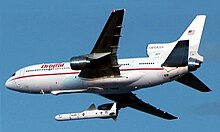BATSAT
| BATSAT | |
|---|---|
| Type: | Communications satellite |
| Country: |
|
| Operator: | Teledesic |
| COSPAR-ID : | 1998-012B |
| Mission dates | |
| Dimensions: | 120 kg |
| Begin: | February 26, 1998, 07:07 UTC |
| Starting place: | Vandenberg Air Force Base , L-1011 , WADZ |
| Launcher: | Pegasus-XL HAPS F20 |
| Flight duration: | 2.5 years |
| Status: | Burned up on October 9, 2000 |
| Orbit data | |
| Orbit inclination : | 97.7 ° |
| Apogee height : | 580 km |
| Perigee height : | 535 km |
Batsat ( Broadband Advanced Technologies Satellite , also Teledesic T1 ) was an experimental communications satellite the company Teledesic to the then planned broadband - satellite constellation to test.
construction
The 120 kg satellite , built by Orbital Sciences Corporation , was based on the MicroStar (triple) satellite bus . The main component was a Ka-band transponder, which should test the two-way communication in the frequency range from 28.6 to 29.1 GHz. The energy supply was ensured via two solar cell booms and associated batteries.
Mission history
The launch took place on February 26, 1998 at 07:07 UTC on a Pegasus-XL HAPS F20. The rocket was dropped from the Lockheed L-1011 TriStar launched from Vandenberg Air Force Base over the Pacific in the Point Arguello Western Air Drop Zone (WADZ). Another payload of this launch was the research satellite SNOE .
BATSAT was the first commercial Ka-band satellite in orbit.
On October 9, 2000, BATSAT burned up when it re-entered the earth's atmosphere.
Individual evidence
- ^ Gunter Krebs: BATSAT (Teledesic T1). In: Gunter's Space Page. Retrieved October 28, 2014 .
- ↑ BATSAT. Retrieved October 28, 2014 .
